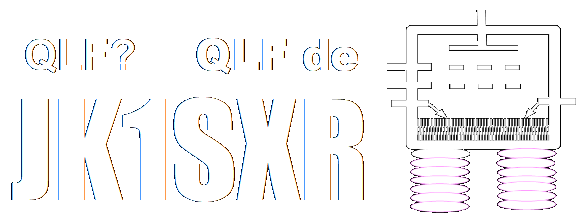
=>Japanese
Return to "A. Home"
Year
2024
2023
2022
2021
2020
2019
2018
2017
2016
2015
2014
2013
& earlier
Return to "A. Home"
Year
2024
2023
2022
2021
2020
2019
2018
2017
2016
2015
2014
2013
& earlier
Snapshot No. 755-759
759. Enkou temple
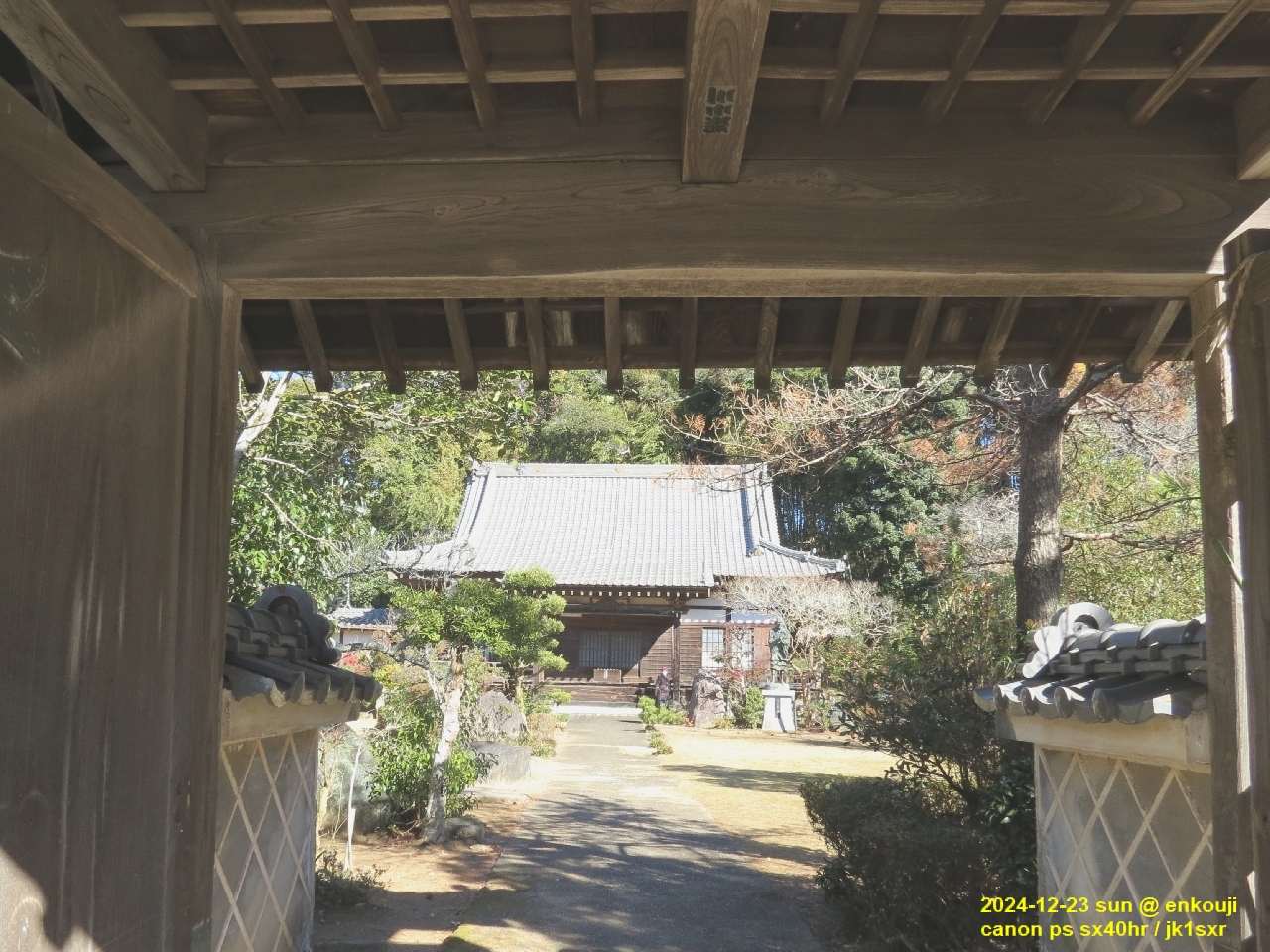
A temple of the Jishu Buddhist sect at Narita, Outake.
The reason I occasionally visit here is that I somehow like the statue of the founding monk, Ippen Shounin, standing there.
In the Medival Ages, Jishu priests had actively engaged in various art and literature forms, as called "Jishu Ami Cultures", and culminated in the Zeami of Noh peformance.
Shounin hailed from the Kawano family which had commanded the "Iyo Sea Forces" controling the Seto Inland Sea. But, at some point, he discarded all of his fortunes, and went to wandering all around the country, from Kagosima in the south to as far north as Touhoku Esasi, as a "sute hijiri" (a monk renounced everything) in order to salvage the people's souls.
The picture scrolls, etc. made later years, following his footsteps naturally depict the religious aspects only. Thus our understanding too tends to remain on the religious side only.
However, it is necessary, at the same time, to understand the background of the times.
His preaching period was in the midst of the troubled times spanning the Mongol Invasions.
The Iyo Forces, which was an important direct vassal of Kamakura Shognate, naturally engaged in the "Bunei War", and again, the subsequent "Kouan War" 7 years later.
Shounin's cousin "Mititugu" fell in the battle, and Mititugu's son "Mitiari" was heavily wounded.
While Shounin himself, after the first invasion, headed for Kyushu in a hurry, despite his monk status, and joined the Ohtomo, lord of Bungo Province, to rebuild and to newly develop hot springs in the Beppu area.
This is said to be for spa treatment of the numerous injured soldiers in the battles. The majority of those killed and wounded in the battles are the people who are soon forgotten in the history stage. But because of that very reason, it must have been imperative that someone extends warm hands to such individuals.
This is probably because Shounin was from a powerful military family, and had enough technical knowledge about hot springs, and especially about the therapeutics using mecdicinal herbs, through the Dougo hot springs known for a long time in his native province.
It is said that the word, "something hijiri" in the old days, meant a vocational group wandering the country with particular technic and art skills. The said skills are like, to locate underground water vein and make wells, to construct reservoirs, to build bridges, to practice medicine, to perform ritual dances at festivals, etc.
Although Shounin proclaimed himself as a "monk renounced everything", in reality it might have been a group with a particular technical skill, or trying to become such one.
And, in later years, especially during the Warring States period, it became common that Jishu monk groups work at battle fields to care the wounded and to make rituals for the perished.
= = =
By the way,
there is an interesting story about the heavily injured "Mitiari" mentioned above.
It is said that one of the scenes in the famous "Mongol Invasion Illustrations and Descriptions" which Takesaki Suenaga made painters depict the battles is for the occasion when Suenaga himself visited Mitiari's mansion to interview him about the battle details of Iyo Forces.
And yet another interesting point here is that the description of that part reads as follows.
- - - iyo no kawano rokurou mitiari - - -
This indicates that the Chinese characters for the family is pronouced "kawano" instead of the usual "kouno".
= = =
I feel that the statue mirrors the times in which Shounin walked and his way of life which could be called harsh.
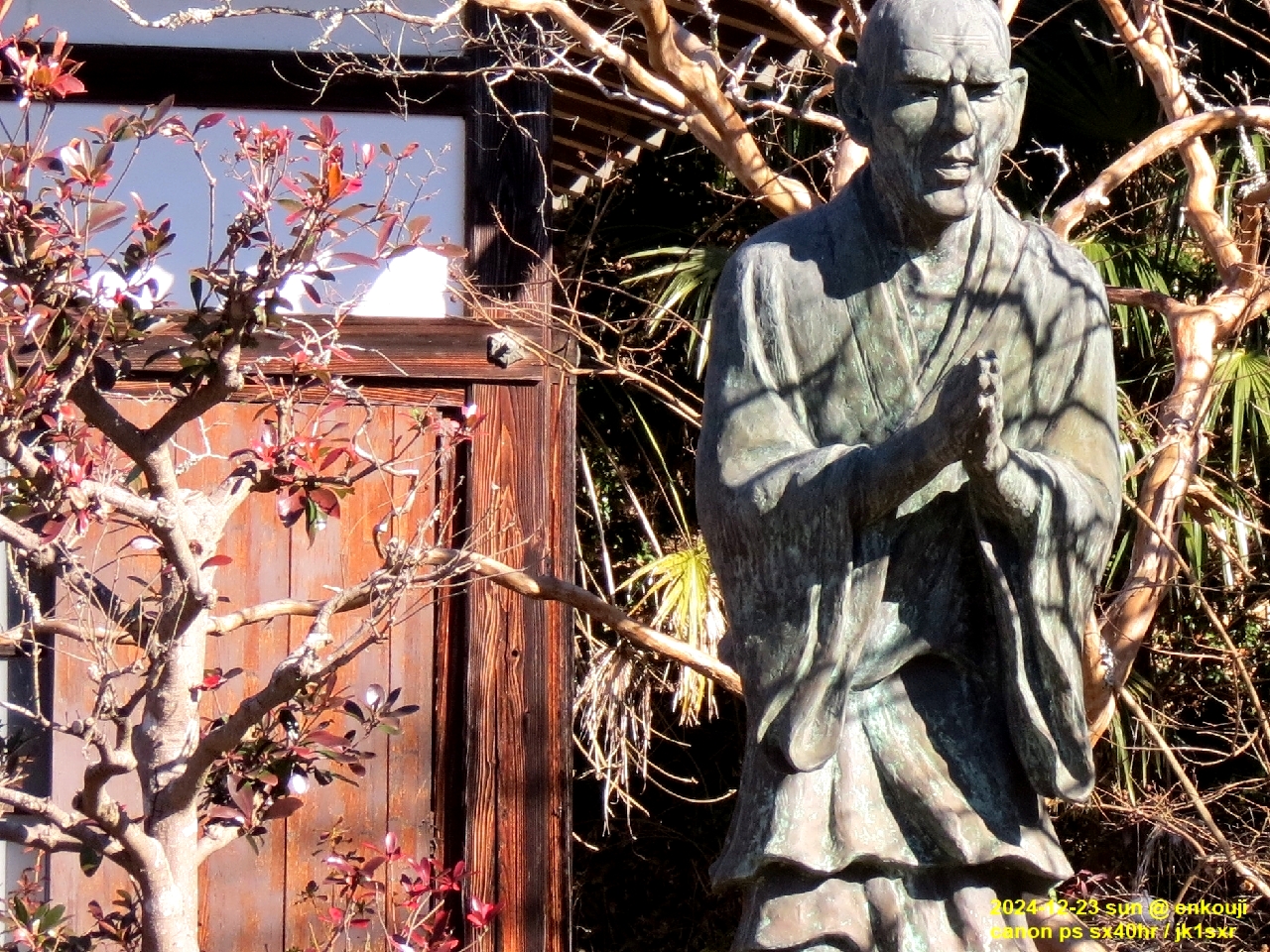
758.@Yoi-no-myoujyou
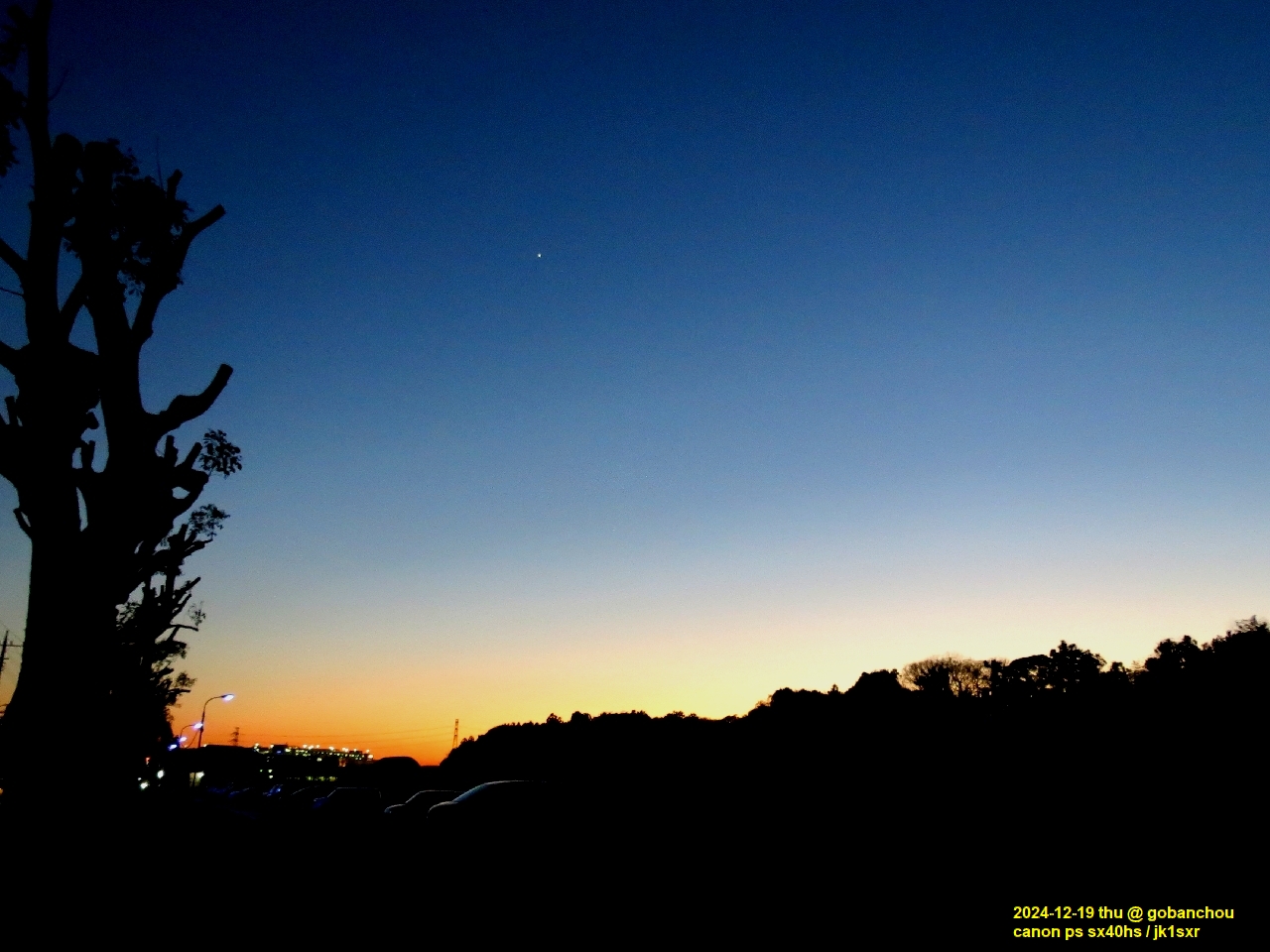 The evening star, Venus, which returned to the evening sky in summer
The evening star, Venus, which returned to the evening sky in summer
is finally gaining its altitude.
The evening sky on Dec. 19th thursday.
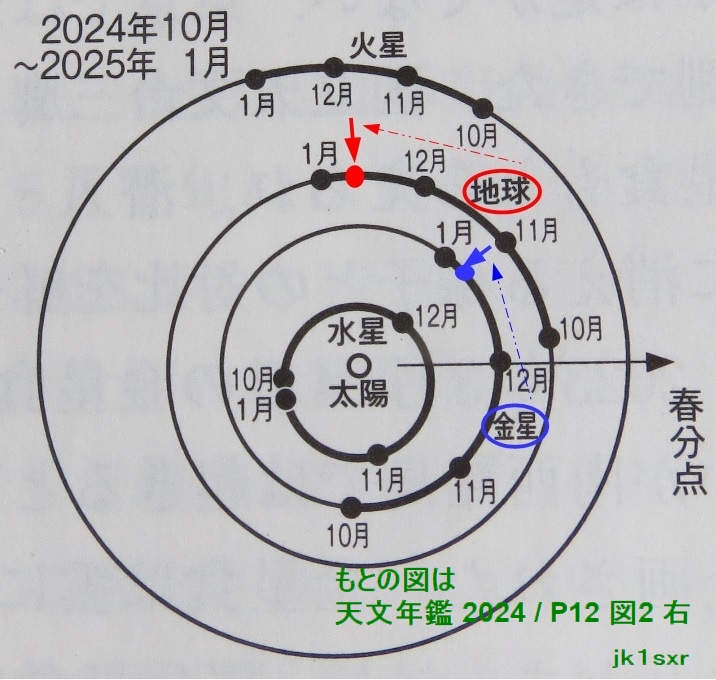 Showing the present positions of the Earth and the Venus on the borrowed picture from the Astronomy Year Book of "Seibundou s.".
Showing the present positions of the Earth and the Venus on the borrowed picture from the Astronomy Year Book of "Seibundou s.".
The original picture shows the orbits of inner planets from Oct.1 to Jan. 1, during which the Earth travels a quarter of its orbit.
757.@A kanmuri kaituburi
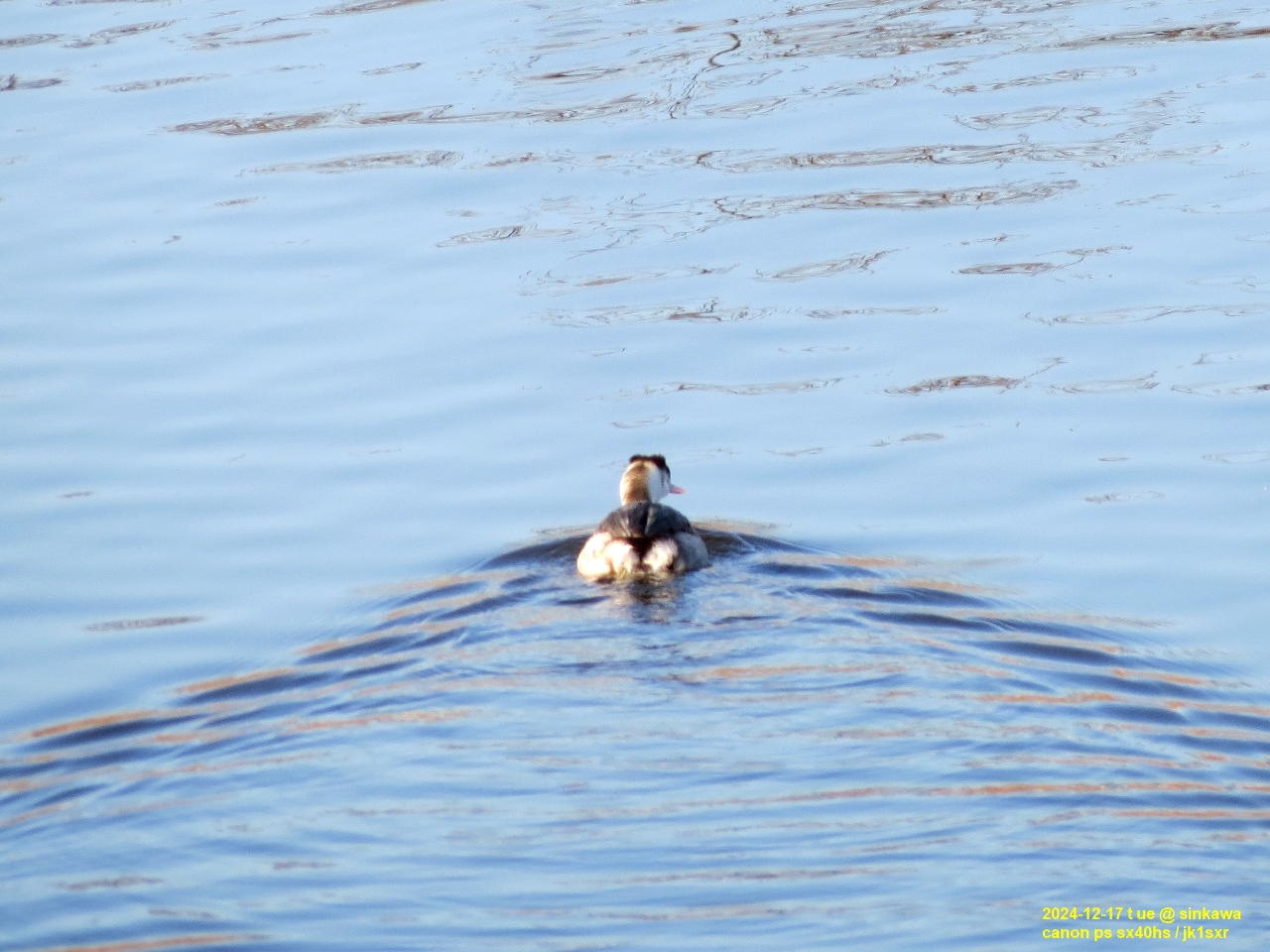
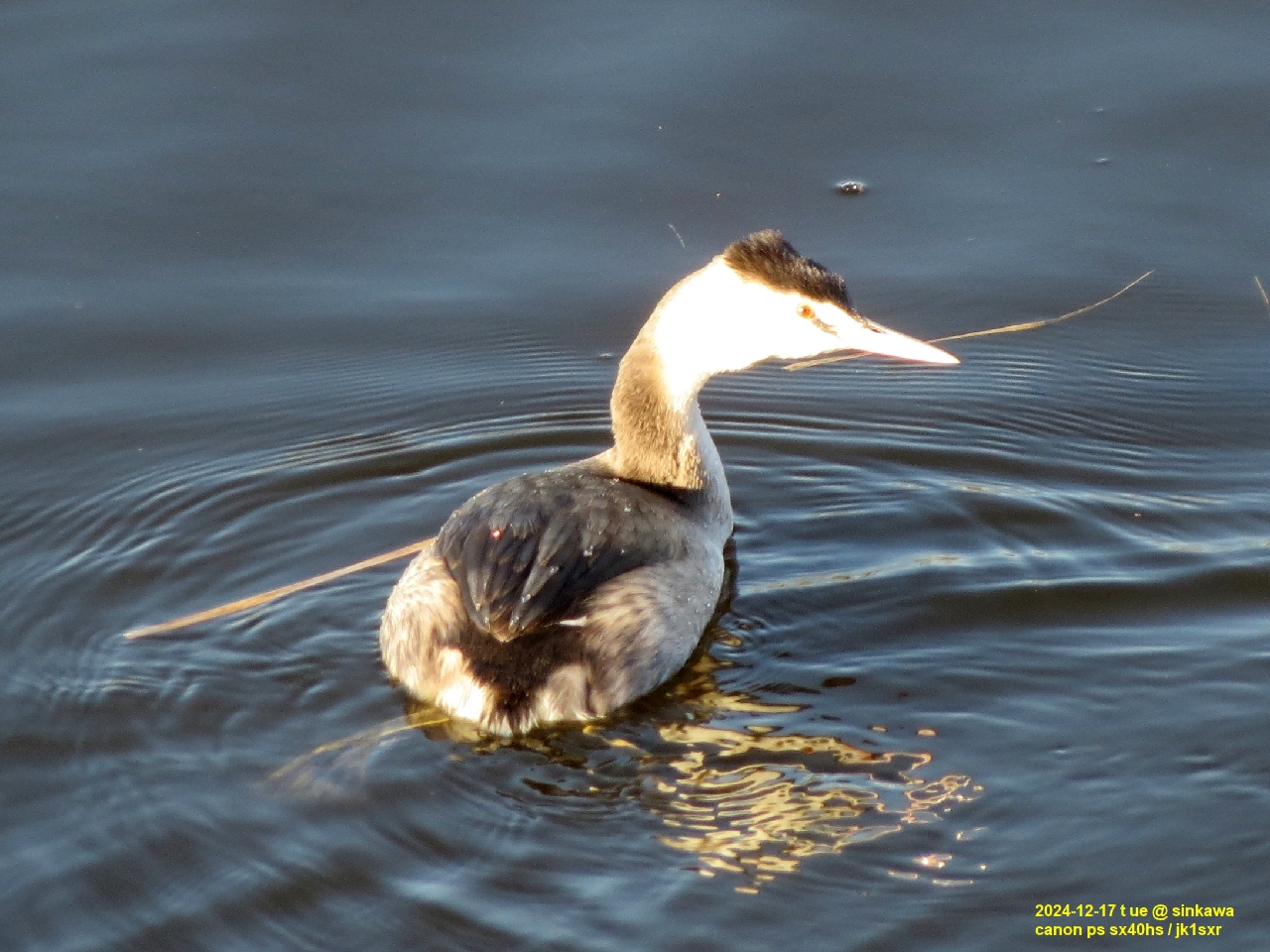
In winter many birds visit rivers and marshes around here.
This is a kanmuri kaituburi seen at the nearby Sin river.
It is a size larger than the ordinary kaituburi and the habit to raise their chicks on floating nests are said to be the same.
This is a winter color. Though I have not seen that of summer, it is said that the color of cheeks and neck is black, and the crown feather is more long.
It is reported that the number of this species visiting here has been increasing these years, and also that there are sightings of breeding inside the country.
756.@I am jealousI
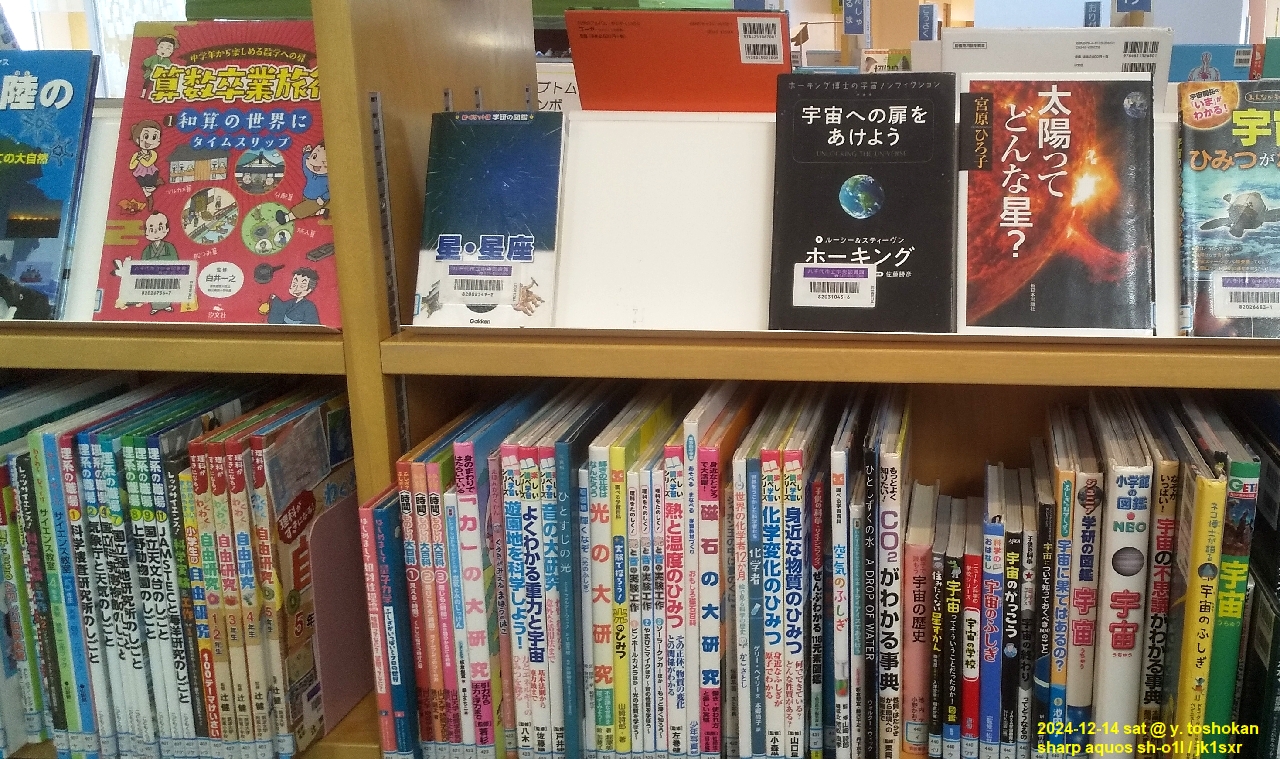
Books of childrens' corner at a nearby library.
Though the books are for children, their contents are all amazingly at a very high level.
I am really jealous of children today.
Facing these children must be tough work for school teachers.
At the same time, it will be rewarding.
755. Looks winter soon
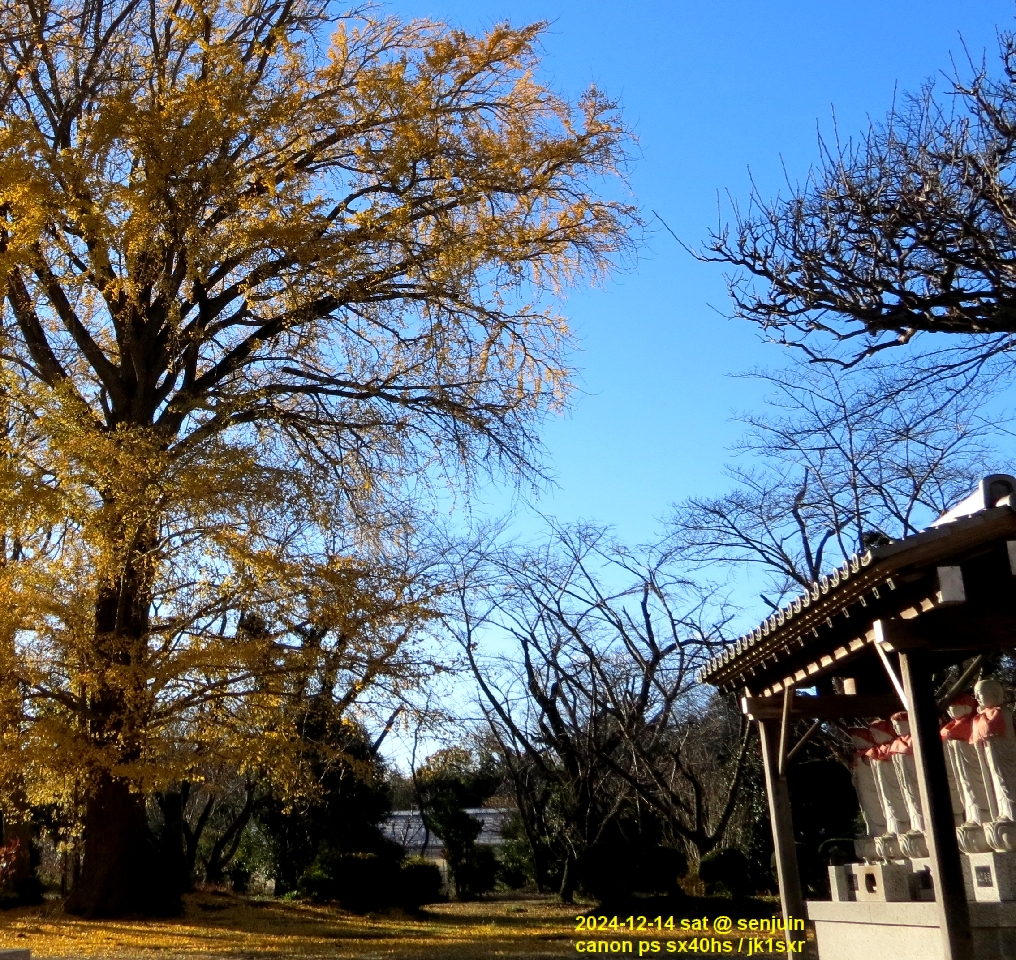 A gingko tree at a nearby temple.
A gingko tree at a nearby temple.
It profusely drops leaves.
The six Jizou statues must think the autumn is being gone.
Seems the period of yellow leaves lasted for 2 weeks or so.
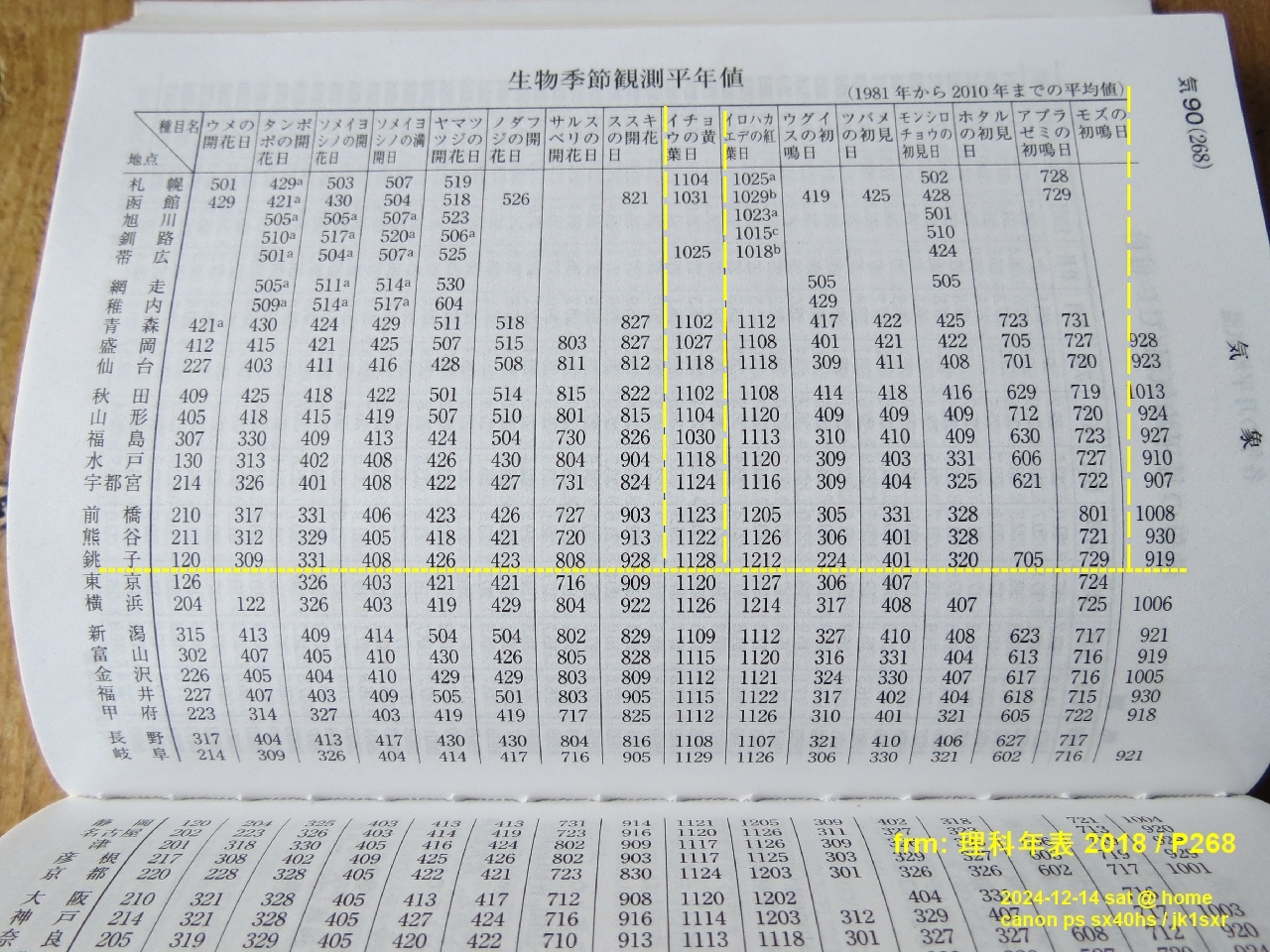 The right shows "Phenology observation normals" of the Science Year Book by the National Astronimical Observatory.
The right shows "Phenology observation normals" of the Science Year Book by the National Astronimical Observatory.
It gives the mean values for the last 30 years. Closest observation points to this area are Tokyo and Chousi.
Though this area is much closer to Tokyo than to Chousi, my experience shows that the data of Chousi match those of our area.
The autumn items include the days of
"susuki ears flowering", "gingko leaves turning color", "iroha maple leaves turning color" and "first cry of shrike returning human habitat".
And the data for "the day of first cry of shrike returnning human habitat" in Tokyo is missing. As this solely depends on the observation point, the blank data seems simply to mean no hearing at the Met. Agency HQ area.
759. Enkou temple

A temple of the Jishu Buddhist sect at Narita, Outake.
The reason I occasionally visit here is that I somehow like the statue of the founding monk, Ippen Shounin, standing there.
In the Medival Ages, Jishu priests had actively engaged in various art and literature forms, as called "Jishu Ami Cultures", and culminated in the Zeami of Noh peformance.
Shounin hailed from the Kawano family which had commanded the "Iyo Sea Forces" controling the Seto Inland Sea. But, at some point, he discarded all of his fortunes, and went to wandering all around the country, from Kagosima in the south to as far north as Touhoku Esasi, as a "sute hijiri" (a monk renounced everything) in order to salvage the people's souls.
The picture scrolls, etc. made later years, following his footsteps naturally depict the religious aspects only. Thus our understanding too tends to remain on the religious side only.
However, it is necessary, at the same time, to understand the background of the times.
His preaching period was in the midst of the troubled times spanning the Mongol Invasions.
The Iyo Forces, which was an important direct vassal of Kamakura Shognate, naturally engaged in the "Bunei War", and again, the subsequent "Kouan War" 7 years later.
Shounin's cousin "Mititugu" fell in the battle, and Mititugu's son "Mitiari" was heavily wounded.
While Shounin himself, after the first invasion, headed for Kyushu in a hurry, despite his monk status, and joined the Ohtomo, lord of Bungo Province, to rebuild and to newly develop hot springs in the Beppu area.
This is said to be for spa treatment of the numerous injured soldiers in the battles. The majority of those killed and wounded in the battles are the people who are soon forgotten in the history stage. But because of that very reason, it must have been imperative that someone extends warm hands to such individuals.
This is probably because Shounin was from a powerful military family, and had enough technical knowledge about hot springs, and especially about the therapeutics using mecdicinal herbs, through the Dougo hot springs known for a long time in his native province.
It is said that the word, "something hijiri" in the old days, meant a vocational group wandering the country with particular technic and art skills. The said skills are like, to locate underground water vein and make wells, to construct reservoirs, to build bridges, to practice medicine, to perform ritual dances at festivals, etc.
Although Shounin proclaimed himself as a "monk renounced everything", in reality it might have been a group with a particular technical skill, or trying to become such one.
And, in later years, especially during the Warring States period, it became common that Jishu monk groups work at battle fields to care the wounded and to make rituals for the perished.
= = =
By the way,
there is an interesting story about the heavily injured "Mitiari" mentioned above.
It is said that one of the scenes in the famous "Mongol Invasion Illustrations and Descriptions" which Takesaki Suenaga made painters depict the battles is for the occasion when Suenaga himself visited Mitiari's mansion to interview him about the battle details of Iyo Forces.
And yet another interesting point here is that the description of that part reads as follows.
- - - iyo no kawano rokurou mitiari - - -
This indicates that the Chinese characters for the family is pronouced "kawano" instead of the usual "kouno".
= = =
I feel that the statue mirrors the times in which Shounin walked and his way of life which could be called harsh.

758.@Yoi-no-myoujyou
 The evening star, Venus, which returned to the evening sky in summer
The evening star, Venus, which returned to the evening sky in summeris finally gaining its altitude.
The evening sky on Dec. 19th thursday.
 Showing the present positions of the Earth and the Venus on the borrowed picture from the Astronomy Year Book of "Seibundou s.".
Showing the present positions of the Earth and the Venus on the borrowed picture from the Astronomy Year Book of "Seibundou s.".The original picture shows the orbits of inner planets from Oct.1 to Jan. 1, during which the Earth travels a quarter of its orbit.
757.@A kanmuri kaituburi


In winter many birds visit rivers and marshes around here.
This is a kanmuri kaituburi seen at the nearby Sin river.
It is a size larger than the ordinary kaituburi and the habit to raise their chicks on floating nests are said to be the same.
This is a winter color. Though I have not seen that of summer, it is said that the color of cheeks and neck is black, and the crown feather is more long.
It is reported that the number of this species visiting here has been increasing these years, and also that there are sightings of breeding inside the country.
756.@I am jealousI

Books of childrens' corner at a nearby library.
Though the books are for children, their contents are all amazingly at a very high level.
I am really jealous of children today.
Facing these children must be tough work for school teachers.
At the same time, it will be rewarding.
755. Looks winter soon
 A gingko tree at a nearby temple.
A gingko tree at a nearby temple.It profusely drops leaves.
The six Jizou statues must think the autumn is being gone.
Seems the period of yellow leaves lasted for 2 weeks or so.
 The right shows "Phenology observation normals" of the Science Year Book by the National Astronimical Observatory.
The right shows "Phenology observation normals" of the Science Year Book by the National Astronimical Observatory.It gives the mean values for the last 30 years. Closest observation points to this area are Tokyo and Chousi.
Though this area is much closer to Tokyo than to Chousi, my experience shows that the data of Chousi match those of our area.
The autumn items include the days of
"susuki ears flowering", "gingko leaves turning color", "iroha maple leaves turning color" and "first cry of shrike returning human habitat".
And the data for "the day of first cry of shrike returnning human habitat" in Tokyo is missing. As this solely depends on the observation point, the blank data seems simply to mean no hearing at the Met. Agency HQ area.
Copyright © 2013 JK1SXR/m.abe. All Rights subject to common sense.